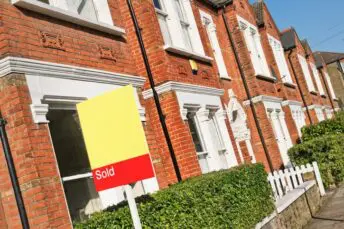House Price Watch Nov 2022
The fallout from the mini-budget continues to impact the housing market with house prices down again in November and the annual rate of growth slowing sharply. While mortgage rates look to have peaked for now, mortgage approvals have continued to fall as some would-be home buyers and sellers have inevitably paused their plans. As we move into 2023, a slower period for house prices is expected. Though the outlook is difficult to predict, we expect there to be an adjustment in prices, down 3-5% in 2023, rather than a sharp fall.
What’s happening nationally
House prices are down on average -1.1% in the past month and annual house price growth has slowed to +7.2%.
Indices reporting on November house prices indicate a significant drop in monthly house prices and continued slowing of the annual rate of house price growth. It is important to look at the individual indices as Land Registry figures precede the mini-budget and reflect a different picture.
Indices based on:
Land Registry – registered property transactions in October.
Nationwide & Halifax – mortgage valuations in November.
Rightmove – asking prices posted on Rightmove in November.
*Rightmove is not included in the index average as the basis for its index is different (asking price vs agreed sale price)
| Index reports: | Monthly change | Annual change |
|---|---|---|
| Land registry | 0.3% | +12.6% |
| Nationwide | -1.4% | +4.4% |
| Halifax | -2.3% | +4.7% |
| Rightmove | -1.1% | +7.2% |
| Average change | -1.1% | +7.2% |
House prices in your area
Most regions in England experienced modest house price growth over the past month with London reporting a fall in house prices. UK areas with the highest monthly growth include Northern Ireland (+4.1%), the North East (+1.9%) and Scotland (1.1%)
Average house prices are highest in London (£541K) and lowest in the North East (£168K).
House price growth also varies by property type. Detached (+12.2%), semi detached (13.9%) and terraced (14.1%) homes have seen higher house price growth and flats/ maisonettes lower growth (+8.6%) according to October Land Registry data.
| UK Region | Average price £ | Monthly change | Annual change |
|---|---|---|---|
| England | |||
| Nothern Ireland | |||
| Scotland | |||
| Wales | |||
| North West | |||
| Yorkshire and The Humber | |||
| North East | |||
| West Midlands | |||
| East Midlands | |||
| South West | |||
| East of England | |||
| South East | |||
| London |
| UK City | Average price | Annual change |
|---|---|---|
Market Monitor
There were 109K transactions in October, 2% higher than September 2022 and 38% higher than October 2021. Note that transactions were unusually low last October because of the end of the final stamp duty holiday last September. 109K transactions is slightly above the usual level for this time of year based on recent years.
Demand continues to fall as do new instructions from sellers. Stock of homes for sale remains low.
Time to sell slows further in November.
How busy is the market?
- Not busy
- Normal
- Very busy
- Transactions up slightly month on month and slightly higher than is typical this time of year.
- Total transactions in October 109K
- up 2% from last month
- +38% from October last year (unusually low transactions with end of stamp duty holiday in Sept last year)
Homes for sale vs homebuyers
- Good availability of homes
- Normal
- Shortage of homes
- Buyer enquiries continue to fall (-38% RICS); seventh monthly drop
- Seller enquiries down (-9% RICS)
- Average stock per agent 48; down slightly (incl under offer/ Sold STC Rightmove)
Average speed of sale
- Fast
- Normal
- Slow
- 45 days to find a buyer up from 40 days (12 month average 36 days Rightmove)
What the experts say
Rightmove

“Economic headwinds including rapidly rising mortgage costs mean some would-be buyers may have paused their plans for the foreseeable future. However, the number of views of homes for sale on Rightmove is up 11% on last year. This indicates that there are many ready-to-go buyers, monitoring and waiting for a calmer market in 2023 after an uncertain last few months of the year. We predict an overall drop of 2% in average asking prices next year as economic headwinds continue to soften activity and lead to a more normal market. We expect a more pronounced hyper-local market, where one side of a city, town or even street could fare better than another, depending on the types of property available and the desirability and affordability of the exact location.”
Nationwide

“The fallout from the mini-Budget continued to impact the market, with November seeing a sharp slowdown in annual house price growth. Prices fell by 1.4% month-on-month, after taking account of seasonal effects, the largest fall since June 2020. While financial market conditions have stabilised, interest rates for new mortgages remain elevated and the market has lost a significant degree of momentum. Housing affordability for potential buyers and home movers has become much more stretched at a time when household finances are already under pressure from high inflation. The market looks set to remain subdued in the coming quarters. Inflation is set to remain high for some time and the Bank Rate is likely to rise further. The outlook is uncertain, and much will depend on how the broader economy performs, but a relatively soft landing is still possible. Longer term borrowing costs have fallen back in recent weeks and may moderate further.”
Halifax

“Though the recent period of rapid house price inflation may now be at an end, it’s important to keep this is context, with average property prices rising more than £22,000 in the past 12 months, and by almost £60,000 (+25.7%) over the last three years. The housing market received a significant shock as a result of the mini-budget and a sudden acceleration in mortgage rate increases. While it is likely that those rates have peaked for now, recent events encouraged existing mortgage holders to look at their options, and some would-be homebuyers to take a pause. Consumer caution has grown with mortgage approvals and demand for borrowing declining. With tax rises and spending cuts expected in the Autumn Statement, economic headwinds point to a much slower period for house prices. While structural market factors which support higher house prices – like the shortage of properties for sale – are likely to remain, how significantly prices might adjust will also be determined by the performance of the labour market.”
Zoopla (Hometrack)

“The fallout from the mini-budget has clearly delivered a shock to sellers and buyers. New sales have been more resilient than some may have expected. Committed buyers and sellers continue to bring homes to the market and agree on deals, although these are fewer in number and harder to negotiate and hold together over the buying cycle. Fall-through rates are higher but not unmanageable for agents. Our data shows that one in 15 homes formerly sold is returning to the market after the original sale has fallen through. All the leading supply and demand indicators we measure continue to point to a rapid slowdown from very strong market conditions. We do not see any evidence of forced sales or the need for a large, double digit reset in UK house prices in 2023. We still expect house price falls of up to 5% in 2023.”
RICS

“The November 2022 RICS UK Residential Survey results show overall activity continues to weaken across the sales market, with higher interest rates and a difficult macroeconomic outlook both taking their toll on buyer sentiment. As a result, house prices have begun to pullback according to the latest feedback, a trend that is expected to continue over the near-term at least.”




